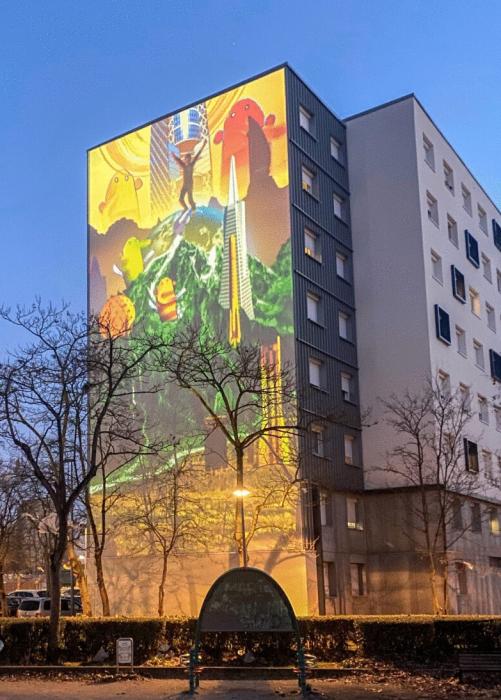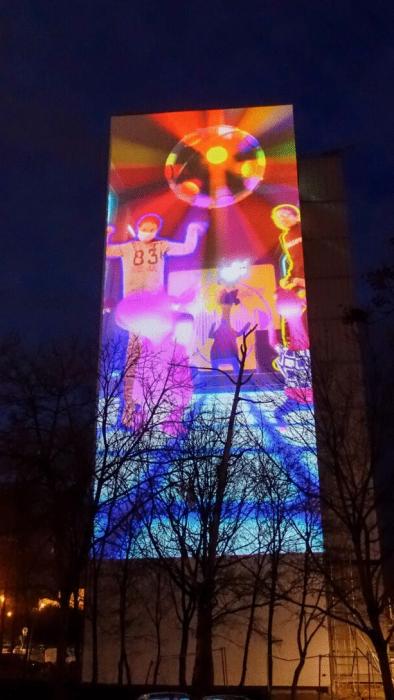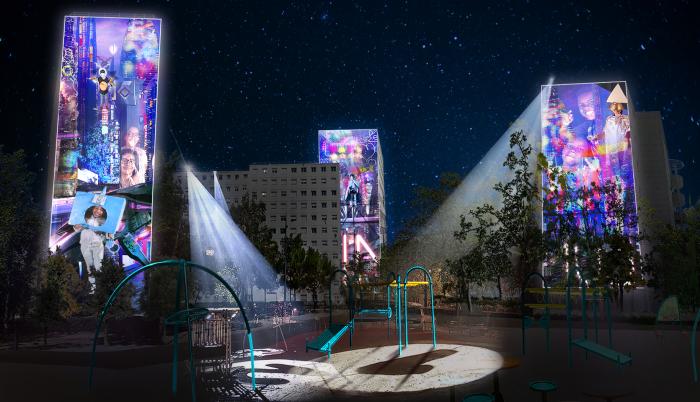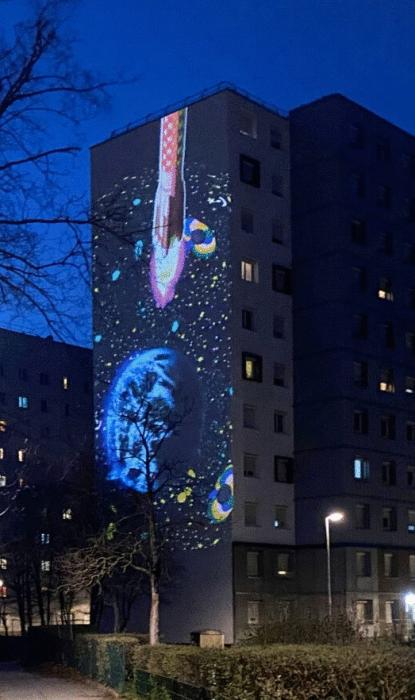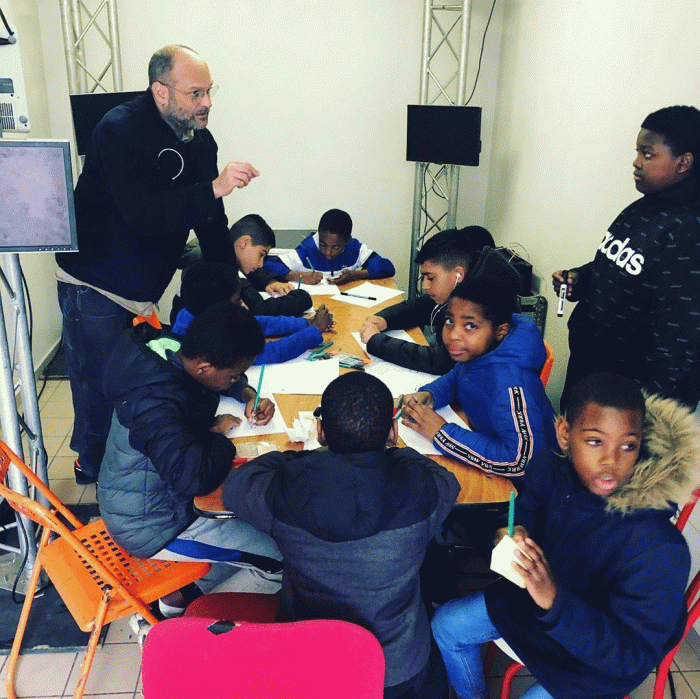I. SUMMARY INFORMATION
Project
268329
Status
Submitted
Award category
Mobilisation of culture, arts and communities
You want to submit
NEW EUROPEAN BAUHAUS AWARDS : existing completed examples
Project title
La Ferme des Lumières
Full project title
La Ferme des Lumières
Description
La Ferme des Lumières is an evolving video fresco co-constructed by the artist Milosh Luczynski and the inhabitants of the Mas du Taureau, projected on the facades of buildings in the district during the year 2021.
Where was your project implemented in the EU?
France
AUVERGNES RHONE ALPES
RUE DE LA FERME
VAULX-EN-VELIN
69120
When was your project implemented?
Has your project benefited from EU programmes or funds?
No
Which programme(s) or fund(s)? Provide the name of the programme(s)/fund(s), the strand/action line as relevant and the year.
II. DESCRIPTION OF THE PROJECT
Please provide a summary of your project
The Mas du Taureau district in Vaulx-en-Velin is currently the subject of a major urban renewal project intended to improve the life of the district in all its dimensions: housing, public space, services. In this context Est Métropole Habitat has entrusted the artist Milosh Luczynski and the projectionist Novelty with the realization of a collective work, conceived with the inhabitants on the theme of "The City of the Future", a future that promises to be brilliant, optimistic where the return to the human being is at the center of the change. Made during multidisciplinary workshops during the year of residency 2020, the creations give rise to a triptych Mapping video fresco projected on a monumental scale on the facades of buildings in the Noirettes district during at least the year 2021. By promoting a different sector heritage sets usually highlighted, this new work strengthens the attractiveness of the district to a large audience. The illumination of the Noirettes allows this district to become a true open-air cultural place in the city. The goal? Offer an artistic project in the form of a video work that follows the changes, projecting towards the future, while taking into account the lived experience and the attachment of the inhabitants to their neighborhood. An opportunity to build a new personal and collective history that generates pride, as was the case for the two frescoes paint on the facades of buildings produced in 2011. Intergenerational and participatory, the project creates a new link between the inhabitants and their relationship to the world, it is the breeding ground through which personal initiatives and vocations may arise.
Please give information about the key objectives of your project in terms of sustainability and how these have been met
Imagine the city of the future within a community means above all immersing yourself in a local environment. With this project, we wanted to lead a reflection on the living conditions perceived through the collective and individual representations of the inhabitants of the district, support them in expressing their desires in terms of transformations and the ideal environment of the future. The artistic team live an apartment in one of the high-rise buildings for the duration of the project during february 2020 to december 2021. An immersive approach that immediately allow equality in relationships and a shared experience. An approach that consciously look for a confrontation with the issues of the place of establishment. The objectives in terms of sustainability here concern the relationship between place of life, living environment as a priority. After a year of residency and multidisciplinary participatory workshops, the six sections of the city of the future - which make up the integral fresco - each postulate a relationship to the city. The 6 topics: Futuristic city, Back to nature, Digital city, City in the space, City as a play area, Underwater city. Although the environmental question in the ecological sense was one of the themes mentioned by the inhabitants (see Return to nature: chapter where nature takes back its rights). Our goal in terms of sustainability is to co-concept a place for each individual in their representation of the future. Inspire residents to change their perspective and consequently question their places in the city, make everyone aware of the construction of a positive future on environmental issues, contribute to meeting times across cultures in a neighborhood where there are deep social difficulties, these are the lasting objectives of the “Ferme des Lumières”.
Please give information about the key objectives of your project in terms of aesthetics and quality of experience beyond functionality and how these have been met
The artistic work created is first and foremost an architectural gesture who change the landscape and looks. Due to its very large scale and its multi-distribution in the form of a triptych, it allows this section of town to be transformed into a monumental scenography. The huge scale of the work in the heart of the district makes it possible to highlight recesses that are not frequented at night. Its size amplifies the experience because even the inhabitants that were not involved in the project can participate just by watching it from their windows. Faced with the diversity of the participating public, we invited for each part of the fresco an artist or a collective in order to diversify the creations. The multidisciplinary workshops have introduced many young people to practices related to image and digital technology. The collective and participatory work in the center of this working-class neighborhood has to be made in a broad legibility. We want it not to be limited to the Noirettes district alone, but to appear in the eyes of more people. As an initiative to follow. The end of the lockdown should mark the arrival of public from outside the district to discover the fresco. The artist of the Milosch project invited other artists to collaborate on each part, which created a community of artists around the project, the artistic team of the Ferme des Lumières is made up of artists from of artistic specialties and different geographical origins: The illustrator artist Katerina Bazantova The 3D artist Sylvain SLY Tardiveau The graphic artist Guillaume Gravier The digital artists Géraldine Delalande and Stéphane Bève The comic artist Cédric Taling The artist and filmmaker Alex Pluquet In terms of aesthetics, our project is therefore based on a sensitive approach, co-conceived between artists and residents. It therefore reflects the diversity of the universes of all these professional actors or users.
Please give information about the key objectives of your project in terms of inclusion and how these have been met
The lighting of the « Noirettes » is above all an artistic process inside of which the inhabitants are. This highlighting is created on the basis of a scenario written with the imagination of those who live daily in this district because this project aims to become a vector of gathering and solidarity, an ode to living. Together and intergenerational ties, allowing everyone to live a creative experience that links them to their neighborhood, to their residence and which is a source of common history and shared pride. These light projections will be the new crucible of local artistic productions, thus making it possible to turn Vaulx-en-Velin into an open-air museum of the 21st century. The project also enabled the hiring of two employees in integration through employment lasting 150 hours each, they are both residents of the neighborhood. We aspire to see the emergence, in the future of talents that will take up the torch. Because at every life course, it is possible to find the trace of an event that has come to influence the personal trajectory. The “Noirettes” lighting project cannot be conceived of as cut off from its various environments. For us, it is a question of bringing into dialogue in an innovative way the various actors of the territory. We build the project with an increased awareness of the context of establishment and of the people who live here. Inclusion is reflected in our project through our desire to work at all levels, to seek out those who did not participate actively through door-to-door operations, to identify mutual support networks and also to create events of monumental size in the center of the district such as La Ferme des Lumières.
Please give information on the results/impacts achieved by your project in relation to the category you apply for
The lighting project, "La Ferme des Lumières", invites the expression of everyone's uniqueness and draws its inspiration from the richness of the intangible heritage of the neighborhood. By its monumental and participatory character, it should make it possible to radically change the way inhabitants perceive at their place of life. The long-term projection device has already been adopted by residents as a large-scale interactive means of communication. It can thus constitute a new and innovative method of creating proximity between neighborhoods. The project took place in a context of the health crisis, (the workshops having started in February 2020 and the distribution of the fresco from December 2020), the Ferme des Lumières allowed the inhabitants of the district to benefit of a date artistic and cultural including during the health crisis. The fresco came to entertainment the community during this long period of confinement and restrictions. The cultural and artistic object, co-concept by the inhabitants of the neighborhood, has been a vector of social cohesion and mobilization of the entire community. Starting by all the children who were the first actors in the project thanks to their curiosity, the thirst to discover and experiment naturally led many children to come and participate in the creation during workshops. These children are both artists since it is their artistic productions that make up the fresco but also spectators. La Ferme des Lumières is a project that has mobilized an entire community through the prism of art and culture. Residents, group of artists, caretakers, social landlord, volunteers. This project is the result of collective work in which each member of the community has been able to play one or more roles in giving birth and bringing La Ferme des Lumières to life.
Please explain the way citizens benefiting from or affected by the project and civil society have been involved in the project and what has been the impact of this involvement on the project
A precise work methodology has been put in place to invite the participation of residents without whom the project could not exist. Long-term residence in the neighborhood, using a room as a participatory, multidisciplinary and intergenerational workshop adapted to each segment of the population and partnerships with other local actors in the city. During the residency period, the results of the day's workshops were projected at the evening from the window of the artistic team's apartment. The inhabitants could thus discover a few hours after their participation a first rendering of their work. This presentation of a first draft was also an invitation to participation for other inhabitants and a first attempt to transform the neighborhood. Social media (especially in times of lockdown) have been of great help in this regard. (For example, the video created in support of the medical profession projected on a building gable has been viewed almost 9,000 times on Facebook). The project launched a dynamic of involvement in which more than 650 inhabitants of all ages participated in the creation workshops. Every evening, at least 500 residents see the fresco from their windows. The artists were also able to benefit from the support of adults in the neighborhood who were involved in the project through the support in the supervision of the workshops, including 3 volunteers who were very active in the project. More than touched by the project, civil society carried La Ferme des Lumières, the co-conception of the artistic work is the very essence of this project. Its main objective is to make civil society a full-fledged artist in the city. La Ferme des Lumières is a project that proves that the density and diversity of the population of a district is an asset, being urban means benefiting from this capacity for permanent emulation that our large cities offer today.
Please highlight the innovative character of the project
For the first time, a participatory video project has been carried out in the center of a district over such a long period (one year of artistic residency and one year of projection at least). And it is precisely the long temporality of the La Ferme des Lumières project that determines its underlying philosophy. The relation to time is revealing here. It is not about "re-enchanting" the neighborhood for one evening to create an illusion, it is about building together, with constancy, a common future and revealing it to the world. It also demonstrates that culture is the ideal breeding ground for fostering encounters beyond social and cultural differences. This project is also unique because it replaces a large group often perceived negatively because of economic and social difficulties as the site of the transformation of our capacity to build the sustainable city of tomorrow. And finally because, as with all the major rehabilitation projects undertaken by the social landlord Est Metropole Habitat, the transformation is not limited to the building but it is also a side step where everyone finds the opportunity to take part thanks to art and culture. It is also thanks to social landlords who, in France, have been driving innovation for decades: technical, social, artistic innovations, and this is also what makes the profession of landlord so rich in responding to this injunction to innovation. It is also the French State that pushes the social landlord to always innovate, to which it responds favorably through many innovative projects such as La Ferme des Lumières. This confidence granted reinforces and encourages French social landlords to cultivate this aspect of the profession. Much more than housing a population, the objective is to provide living and it is through innovation that we can offer an ever more qualitative and constantly evolving way of living. It is innovation that allows us to adapt our offer to major changes in our society.
Please explain how the project led to results or learnings which could be transferred to other interested parties
Due to its monumental character, this project adapts perfectly to large housing estates. Each neighborhood could potentially be the creator of a fresco or other artistic intervention that would show its identity as a window to the world. The results: The Ferme des Lumières contribute to a change in the image of the neighborhood on a metropolitan scale, the project has become an example given the involvement of the entire community. “La Ferme des Lumières” is an extension of other cultural initiatives that we carry. When a residence is the subject of major renovation work, we offer various artists the opportunity to develop a project that strengthens the social bond between residents and helps to improve the perception of working-class neighborhoods. Over the years, the inhabitants of the following neighborhoods have contributed to an artistic work, for example the theater, dance, ephemeral museum.... It is a transferable project since it has shown how participation on a cultural basis carried by artists has allowed everyone to express themselves regardless of their origins and abilities. In order to build a positive collective imagination, we deeply believe these are in times of great change that we can encourage the emergence of new, positive and surprising initiatives and of unsuspected behavior on the part of inhabitants who would not have had the opportunity to distinguish themselves without this framework. The cultural dynamic within the framework of refurbishment projects is already present through many actions already implemented in the districts that we manage. La Ferme des Lumières taught us how to manage a large-scale artistic project over a two-year period. Based on this experience, we strongly wish to share our learning. As with every innovative project, improvements could be made. We are pleased to have been able to continue to carry out La Ferme des Lumières despite the pandemic, thanks to the involvement of an entire community.
Is an evaluation report or any relevant independent evaluation source available?
No
III. UPLOAD PICTURES
IV. VALIDATION
By ticking this box, you declare that all the information provided in this form is factually correct, that the proposed project has not been proposed for the Awards more than once under the same category and that it has not been subject to any type of investigation, which could lead to a financial correction because of irregularities or fraud.
Yes
